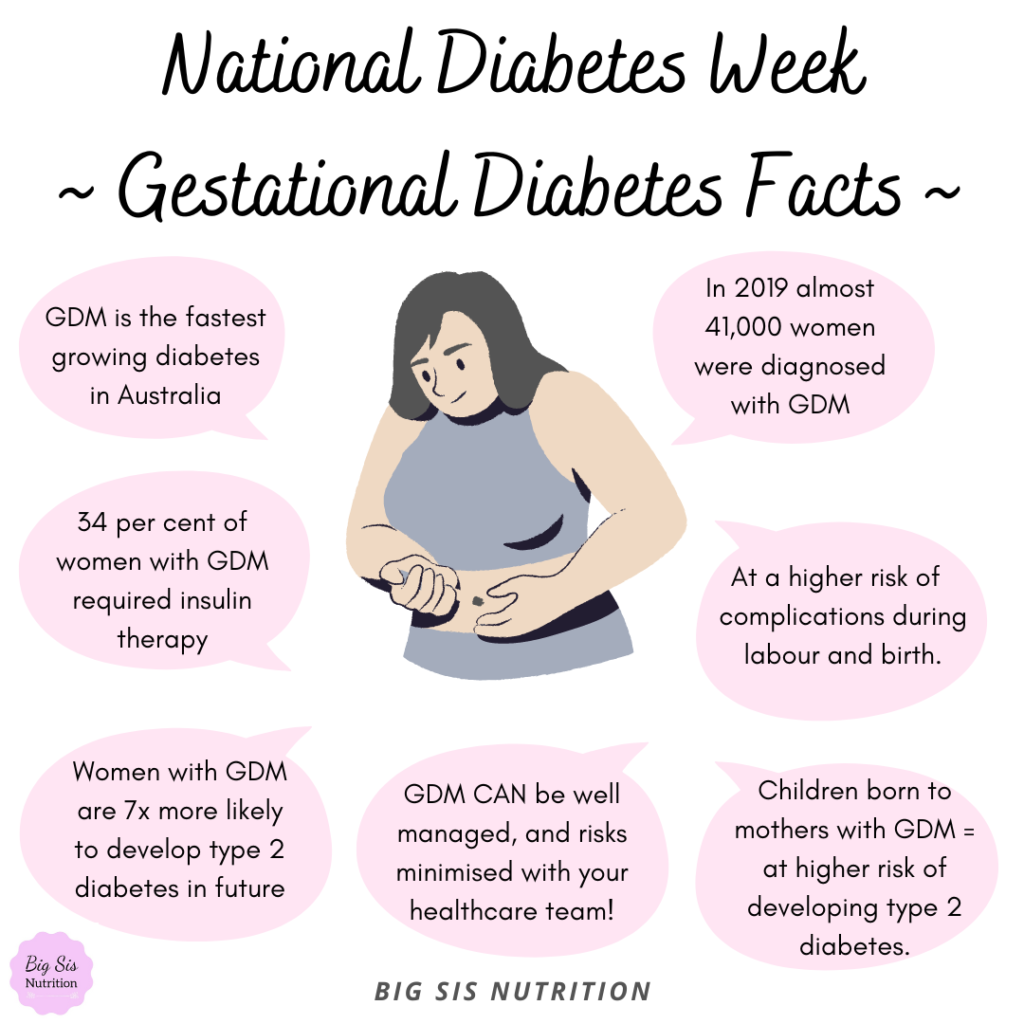Pregnancy can be a beautiful time, but growing a new little human is hard work. Many people feel the pressure, and sometimes guilt when they are diagnosed with gestational diabetes (even though no one should be made to feel this way – because it is not your fault). This blogs aims to ease some of the anxiety around what to eat for gestational diabetes management.
What is Gestational diabetes?
Gestational diabetes (GDM) is a type of diabetes that happens in pregnancy, and is diagnosed when higher than normal blood glucose levels occur. This happens due to a reduced ability of the pancreas to produce adequate levels of insulin. Most people will not continue to have diabetes once their baby is born, however for some, these high blood glucose levels continue after delivery. 5-10% of pregnant people will develop gestational diabetes. The hormones involved in helping the baby grow can interfere with the production of insulin. A pregnant person’s body has to continue to make more insulin to keep blood glucose levels in range. This becomes more difficult as a pregnancy continues, and then gives way to gestational diabetes.
How is GDM diagnosed?
Gestational diabetes is diagnosed with the use of an oral glucose tolerance test (OGTT). This type of test involves a fasting blood tests to be taken before consuming the 75g glucose drink, and after consuming the drink (with tests taken 1 hour after, and 2 hours after). If any of these results are high at any timepoint, a diagnosis of gestational diabetes is given. The OGTT is usually performed between 24 and 28 weeks of pregnancy. This can occur earlier if you are at high risk.
Some risks of gestational diabetes development include:
– Age (greater than 40 years of age in pregnancy)
– Family history of type 2 diabetes
– Are from particular cultural groups (Aboriginal or Torres Strait islander, Indian, Chinese, Middle eastern or Polynesian)
– Previous gestational diabetes in pregnancy
– Having PCOS (polycystic ovary syndrome)
However, sometimes it just happens, and there are no known risk factors. Symptoms can be difficult to diagnose, as they are associated with “usual pregnancy” symptoms also. Some main symptoms include excessive thirst, tiredness and urination, and recurrent yeast infections (thrush)
Management of Gestational Diabetes
The aim of any diabetes management, is to keep blood glucose levels in the recommended range (in Australia this is 4 – 6mmol/L). Some ways diabetes is commonly managed in gestational diabetes:
– Checking blood glucose levels with a monitor.
– Use of insulin
– Healthy eating / Nutrition changes
– Physical activity
Why is it important GDM is managed?
Unfortunately, unmanaged gestational diabetes can have some really terrible consequences.
This includes:
– Macrosomia (large birth weight baby, which is a baby over 4.5kg)
– Shoulder dystocia
– Intervention during delivery
– Increased risk of emergency c-section
– Increased risk of miscarriage or stillbirth
For those with gestational diabetes, there is a 50% increased risk of type 2 diabetes development later in life, and an increased risk of high blood pressure and/or pre-eclampsia in pregnancy. Babies whose mothers had gestational diabetes are at a higher risk of developing type 2 diabetes later in life and also at an increased risk of gestational diabetes in pregnancy. It is important to note that a baby is not born with diabetes if their mother has gestational diabetes.

The Role of Nutrition in Gestational Diabetes:
Nutrition is the cornerstone of managing gestational diabetes. Having a dietitian as part of your gestational diabetes team can help in reducing some of the stress around choosing how and what to eat.
There are some simple swaps to make than can help in managing your gestational diabetes
1. Have a good understanding of what carbohydrates are
Carbohydrates are generally the body’s preferred energy source. Carbohydrates are broken down as glucose into the body. These are what directly impact changes in blood sugar levels. There are higher quality, and poorer quality carbohydrates. Carbohydrates are found in “obvious foods” such as bread, pasta, rice, cereal and potatoes, however they are also found in fruit, some vegetables and dairy products.
2. Focus on the type of carbohydrate
Foods that contain higher quality carbohydrates include bread, pasta, rice, noodles, roti, corn, potato, breakfast cereals, fruit, milk, yoghurt, lentils, and legumes. Foods that are sources of poorer quality carbohydrates include sugar, biscuits, cakes, pastries, chips, lollies and chocolate. The best source of carbohydrates are wholegrains, fruits, vegetables and legumes. Wholegrain carbohydrates include: wholegrain or multigrain breads or crispbreads, dark ‘seedy’ breads, wholegrain breakfast cereals, wheatgerm, brown rice, bulgur, quinoa, wholemeal couscous, popcorn and oats.
3. Build your plate
Adding a portion of protein, and lots of colour (e.g. vegetables) can help to manage carbohydrate portions. Having good intake of vegetables is amazing for every area of your health. Based on years of evidence-based research, meeting your recommendations both fruits and vegetables can reduce your risk of some cancers, and cardiovascular disease. Vegetables are high in antioxidants (which means they aid in protecting our body cells) and mostly low in carbohydrates. So load up your plate with colourful vegetables!
4. Have a good team to support you
Being diagnosed with gestational diabetes can feel isolating, and a bit overwhelming. Building a good team around you, such as a dietitian, diabetes educator, obstetrician/gynaecologist and GP can make the diagnosis and management feel a bit more manageable.
What happens after baby is born?
For most people, once their baby is born the gestational diabetes stops. People’s blood glucose levels generally return to normal levels post birth. For babies, once they are born, it is important to monitor their blood glucose levels, as they have their own insulin stores in utero (separate to mums). Babies of mums with gestational diabetes have blood glucose levels that lean bit higher in utero (as they share blood with mum) so more insulin is needed for them to keep these in range. Once they are born, their bodies can continue to produce higher levels of insulin, which can lead to low blood glucose levels. This can be balanced again by feeding the baby with breastmilk or formula. Post birth, the blood glucose levels of both mum and baby are checked to make sure they fall in the ideal range. The OGTT is repeated within 3 months of babies birth to check that the gestational diabetes has gone away.
Living with gestational diabetes can present unique challenges, but remember, you are not alone. By prioritizing your nutrition, adopting a healthy lifestyle, and accessing the right resources, you can successfully manage gestational diabetes and promote the well-being of both you and your baby.
Book an Appointment Today!
So, are you ready to take that critical step towards improved health? Click here to book an appointment with Big Sis Nutrition today! You deserve to thrive, and we’re here to help you every step of the way.


